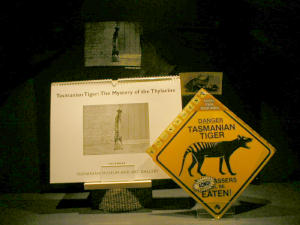University zoologists have long maintained that the 'Tasmanian tiger", or Thylacine, died out on the Australian mainland around 3,000 years ago and that the last Tasmanian specimen died in Hobart Zoo in the 1930s, yet hundreds of recent sightings reports suggest not only that some of these marsupials still linger on in the remoter areas of Tasmania, but that they continue to survive in Australia's eastern mainland wilderness areas in much larger numbers.
The reason for their demise in Tasmania is well known. Beginning last century when settlers considered them pests and hunted them because of frequent attacks on their poultry and livestock, they were soon being slaughtered for their fur. However, it is argued now that many of these poultry and stock killings were actually the work of that other, smaller, ferocious marsupial carnivore, the 'Tasmanian Devil".
It has been suggested that the Tasmanian population of Thylacines will eventually die out. This assumption is based upon the view that too few of the unfortunate creatures now survive in that island-state, with males and females so widely scattered that it is difficult for them to meet for breeding purposes.
Yet there are signs, as shown from the increasing number of sightings claims in certain years, that the Thylacine's numbers may have increased. Even so, as will be seen, the mainland Thylacine population may be in a far better situation, with small breeding groups scattered over a vast area of the eastern mountain ranges.The fossil record of the Thylacine now stretches back at least two million years.
They roamed a landmass which in those times, during the last great ice age, included New Guinea as well as Tasmania. According to anthropologists, the introduction by Stone Age people of the dingo from South East Asia around 8,000 years ago, coupled with Aboriginal hunting activities, reduced Thylacine numbers on the mainland long before European arrival, by which time they claim it was already extinct here.
The final flooding of Bass Strait, around 12,000 years ago, isolated the Tasmanian Thylacine population until European settlement. Regardless of the accepted scientific view that these creatures are now totally extinct, particularly on the mainland, we shall now examine evidence to the contrary, beginning with one of their favourite haunts, the Blue Mountains of New South Wales.
In television interviews I am often asked what drives me to continue my search, year after year, for creatures regarded by university zoologists as long extinct. The interviewers ask why I believe the Thylacine still survives in mainland Australia.
My Answer Is Threefold.
First, there are a large number of eyewitness claims of sightings of often large, striped, dog-like animals, possibly Thylacines, coming from over a wide area of the rugged eastern Australian mountain ranges from far north Queensland through New South Wales to eastern Victoria.
Second, plaster casts have been taken of tracks found on the mainland which compare with others from Tasmania, leaving no doubt as to the animal's identity.
Third, I have had my own sighting of a Thylacine. On Tuesday 22nd February 1972 at 10.15 pm, a female companion and I were driving along the Great Western Highway just south of Blackheath toward Katoomba in the Blue Mountains of New South Wales. As we approached the left-hand turnoff to Evans Lookout, at the corner of the local council water catchment fence which encloses a vast area of dense scrubland, we saw in the glare of the car's headlights a strange animal.
It was dog-like and about the size of a full-grown Alsatian, with fawn coloured body fur and a row of blackish body stripes extending barrel-wise from mid-back to tail-rump. The animal had been walking across the highway (usually quiet thereabouts on a weeknight) when we saw it, forcing us to brake quickly. By this time our car was but a few feet from the animal which just stood there staring at our vehicle, mesmerised by the headlights' glare. In the few seconds before the animal dashed off the road into the darkness of the catchment scrub, we were able to get a good look at it.
Apart from its size, it was greyhound-like in appearance with narrowing flanks, its body sloping downward to a long, thin tail which followed the slope of the back and seemed kangaroo-like in that it did not appear to wag. The shape of the head, legs and body was unmistakable. It was a Tasmanian Tiger. Its physical appearance matched that of stuffed specimens preserved in government museums.
The creature had escaped into scrubland which extends eastward to a gully which drops down into the Grose Valley-where sightings of Thylacine-type animals continue to be reported by campers and bushwalkers to the present day.






